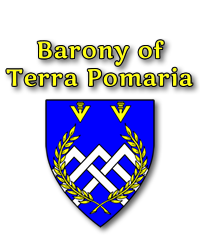17 Jun Salat (Salad)
Then Serve It Forth…
By Lady Rosemary Willowwood de Ste. Anne
“Sumer is icumen in”, and the thought of cooling salads will be on everyone’s mind. I offer a medieval salad for your enjoyment. It is, however, not what you think. There’s not a leaf of lettuce to be seen in it.
“Salat”
From The Forme of Cury, compiled … by the Master-Cooks of King Richard II
From about 1390
Take psel, sawge, garlec, chibolis, onyons, leek, borage, mynt, porrects, fenel and ton tresses, rue, rosemarye, purslanye, laue and waische hem clene, pike hem, pluck hem small with thyn honde and myng hem we with rawe oyle. Lay on vynegar and salt, and serve it forth.
TRANSLATION: Take parsley, sage, garlic, chibblings (see glossary), onions, leek, borage, mint, porets (see glossary), fennel and town cresses (see glossary), rue, rosemary, [and] purslane, lave and wash them clean, pick them [off the stems]. Pluck them small with your hands and mingle them with raw oil. Lay on vinegar and salt and serve it forth
REALIZATION: This salad is simplicity itself to make, once you get past the idea that there is no lettuce in it. USE FRESH HERBS; DRIED STUFF DOESN’T WORK HERE! Mix approximately equal amounts of chopped fresh parsley, sage, borage, mint (both spearmint and peppermint work here) and watercress with chopped garlic, sweet onions, strong onions, leek (white part only), scallions, fennel (sweet anise). Toss gently with a 3-to-1 mixture of olive oil and vinegar, and add a light sprinkling of kosher salt. Pile it on toast, roast meats, toss it with warm vegetables, serve it on the side with a casserole, or just steal occasional spoonfuls out of the bowl in the ‘fridge. It is just delicious! The aim here is not a salad that you eat as a separate course in a meal, but a condiment to “dress up” other dishes on the table. If you shoot for a texture like a chunky salsa, you will have it about right. However, if you must have lettuce in your salads, mix a generous handful of the herb/onion mixture (before dressing) into lettuce for a salad, and dress lightly with the oil and vinegar dressing. Works that way, too.
If you have been referring to the glossary, you will see that this is a very onion-y condiment. Fresh, it can be very crunchy. However, the longer it sits in the dressing, the more limp the vegetables will get, the more the flavors will blend, and the more like a salsa it will become. This dish is also a chance to use your creativity and artistic bent. Try half red onions, white Walla Wallas, and green scallions, with the blue borage flowers for a really striking color mixture. Play with the herbs all you want. As long as you use about half alliums (onions and their ilk) and half herbs, you are on the right track.
GLOSSARY:
Borage: You should be a little cautious about the borage, bur not because it is dangerous. Borage leaves are hairy and prickly to the tongue, especially as they get older. If you use the leaves, take small young leaves from the growing tips of the plant. However, the lovely blue flowers are quite tasty, enchanting to look at, and fairly prolific on the plant. Use them freely. But don’t let them sit too long in the salted dressing – they will go limp and lose all their charm
Chibolis: Small onions. The Oxford English Dictionary, 3rd Edition, describes them as “A species of onion known also as Stone Leek, Rock Onion or Welsh Onion, in appearance between the onion and the leek.” It is supposedly analogous to the Italian cipolla, onion. Italian cippolini are a flat, button-shaped, thick-fleshed, very sweet onion. Walla Walla Sweet onions would be a good substitute, if you can’t find the real thing.
Porrects: Again from The Oxford English Dictionary, 3rd Edition, “a young leek or onion; a scallion.” For the linguists in the crowd, it is derived from the Old French poret, leek, with a diminutive suffix; a “little leek”.
Town Cresses: Upland cress. This is a watercress-like plant that grows on drier land than watercress. You can buy upland cress plants if you want to grow it yourself, but watercress or any other peppery green will do. Watercress is frequently available with the herbs at supermarkets.
Purslane: If you have not used chemicals on your garden, this is the same nasty weed you have been digging out (probably while cursing, if you are so inclined) for years. Get your revenge by eating it for dinner! Or substitute another lemony herb, perhaps marjoram or lemon balm.
Fennel: You may be familiar with this plant in seed. It’s worth getting to know as a green plant as well. It’s the knobby green celery-like thing you find in the stores that has ferny foliage and smells faintly of licorice.



